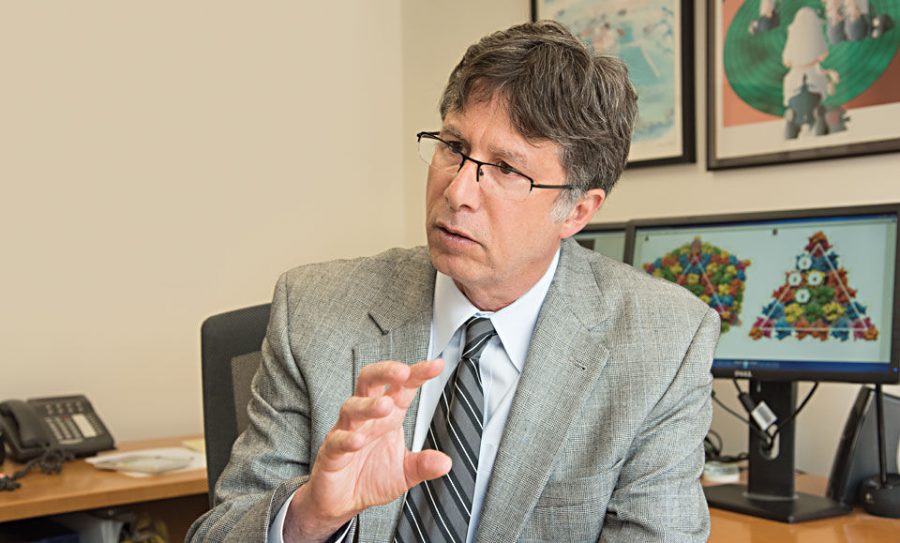WU researcher pioneered process used in COVID vaccines
Published March 9, 2021
Much of the discussion about the COVID-19 vaccines has centered around high and low speeds.
For example, the U.S. government was able to accelerate the development and production of COVID-19 vaccines by guaranteeing funding to companies such as Moderna and AstraZeneca to shield them from financial risk so that they would produce doses of their vaccines before they knew whether the Food and Drug Administration would approve them.
Now people are frustrated by hiccups in the vaccine distribution process that keep them from getting inoculated as quickly as they would like.
But what if all the parties involved with the vaccine process had a 25-year head start?
That might have been the case had pharmaceutical companies taken advantage of the promising of results of the research of Dr. David Curiel, a cancer biologist who is Jewish and now lives in St. Louis and works at Washington University.
In 1995, Curiel was working in a laboratory at the University of Alabama-Birmingham and discovered that you could use messenger RNA (mRNA) molecules to express the genes that serve as markers for cancer and could then act as a vaccine.
He was the first person to prove that mRNA could work in such a capacity, and his findings were published in the prestigious medical journal Cancer Research and attracted significant interest.
Then nothing happened.
The practical benefits of his research were stymied by technological challenges that are now also serving as an obstacle to the distribution of the mRNA COVID-19 vaccines produced by Moderna and Pfizer.
But had pharmaceutical companies utilized his findings then, Curiel said, “We might have gotten to the COVID vaccine faster, and some of the problems that still exist with the mRNA vaccine — that it is unstable and requires extreme storage conditions — those might have been solved by now.
“It would have been nice if there wasn’t a 25-year quiet period in the development of the technology.”
Still, Curiel does not sound bitter about the past and was willing to endure a sore arm after receiving the Pfizer vaccine.
Curiel is working on overcoming the challenges that have been inherent in the storage and distribution of vaccines — for the next pandemic.
In the meantime, he implores the public: “Take the vaccine, any [COVID-19] vaccine, that you are offered as quickly possible. The ones that are out there work.
The primary factor that hindered the adoption of Curiel’s research in 1995 was temperature. The mRNA molecule is not stable, meaning that it can easily be broken down by other molecules, and a vaccine using it can then become ineffective. But the degradation process can be slowed by storing it at extremely cold temperatures. For example, the Pfizer vaccine must be stored at minus-94 degrees Fahrenheit.
After Curiel completed his research, he approached Ambion, a company that produced kits to manufacture mRNA in a laboratory, and told them that there was a grant from National Institutes of Health that would allow the company to develop Curiel’s data into a vaccine.
He asked: “Would you like to endeavor this together?
“I will never forget their response,” he said. “They said they didn’t see any commercial potential of mRNA for medicinal applications, so it was hard to traverse that level of resistance and get help with these technical tasks.”
Dr. Matthew Powell, a gynecologic oncologist at Washington University, attributes the earlier lack of adoption of Curiel’s research to the fact that when you are disrupting the status quo and people’s previous conceptions of how things should be done, “they will immediately come back with a negative response.”
The infrastructure needed for mRNA vaccines, known as a cold chain, continues to pose a challenge, particularly in developing countries that may not have the necessary refrigeration technology.
Curiel’s father immigrated to the United States from the Dominican Republican, and the scientist still has about 20 relatives who live in the Caribbean country. Curiel has served as an advisor to its government.
The Dominican Republic is looking to vaccines produced by Russia and China because they don’t need to be stored at such a cold temperature.
The American rivals are using their vaccines “as an agent of diplomacy,” Curiel said.
Meanwhile, Curiel is now also working on a COVID-19 vaccine that could prove particularly useful in the developing world.
At a laboratory at WU, Curiel and Dr. Michael Diamond, a viral immunologist, produced a nasal vaccine that Curiel’s company, Precision Virologics, has licensed the rights to for distribution in the United States, Japan and Europe. Bharat Biotech in India has acquired the rights to distribute it in that country.
Unlike the potential cancer vaccine all those years ago, the nasal COVID-19 vaccine is based on an adenovirus, not mRNA, a source that had a longer history in vaccines, meaning there has been more research done on its long-term implications – and it does not need to be stored at a super-cold temperature. AstraZeneca and Johnson & Johnson also produced vaccines based on adenoviruses.
India, which does not have the cold chain technology needed for mRNA vaccines, began administering Curiel’s vaccine in February as part of a Phase 1 trial. Curiel hopes to have results by May.
Curiel wrote in an email that he is “pleased!!!” that others are now also seeing the potential of mRNA.
“Many of us do this for the possibility of human impact,” he said. “This impacted beyond my wildest expectation.”
And that human impact may extend beyond COVID-19 or even another pandemic. Powell, the oncologist, is testing Curiel’s adenovirus technology to more precisely treat ovarian and pancreatic cancer and avoid killing noncancerous cells during chemotherapy.
“The guy is brilliant and an amazing mentor to his mentees and has so many unique solutions for problems,” Powell said. “I feel the [adenovirus technology] has so much potential to solve some of the problems we have.”















